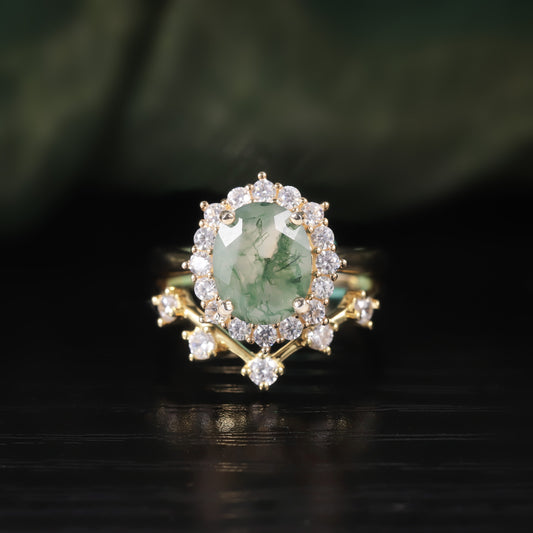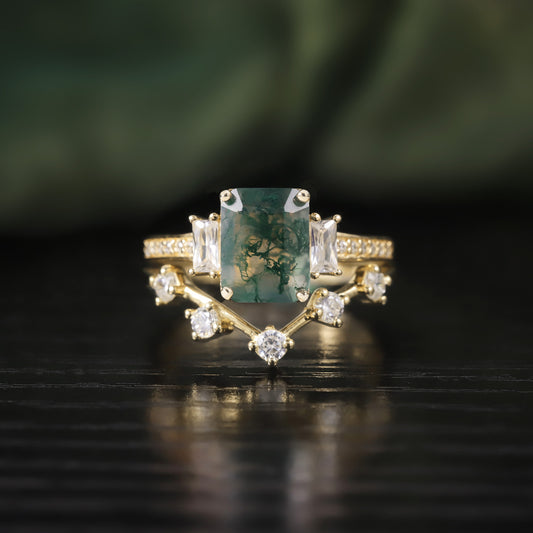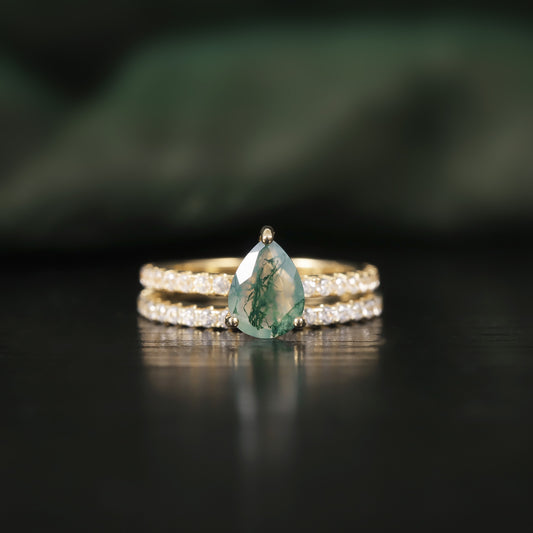Catalog:
- Introduction: Discusses moss agate's popularity and concerns about its interaction with water.
- Composition and Properties: Describes moss agate's physical, chemical, and visual characteristics.
- Interaction with Water: Explores how water affects moss agate, including its vibrancy and potential risks.
- Care Tips: Offers advice on protecting moss agate from water damage.
- Use in Water-Related Practices: Explains moss agate's role in spiritual and healing practices involving water.
- Myths vs. Facts: Debunks common misconceptions about moss agate's ability to purify water.
- Moss Agate Jewelry and Water: Advises on the care of moss agate jewelry in relation to water exposure.
- Maintenance of Moss Agate Jewelry: Provides tips for cleaning and maintaining moss agate jewelry.
- Conclusion: Summarizes the importance of managing moss agate's exposure to water.
When it comes to sustainable jewellery, moss agate is one of the best diamond alternatives. Not only is it popular for its unique appearance, people are also adopting it as the main stone of their wedding and engagement rings. Though moss agate is not as costly as diamond, those who buy it often think that it is not safe to put them in water.
If you think the same way, this article is here for you to answer your question: can moss agate be safely placed in water? Read on to know about all the properties of moss agate stone and what makes it safe to use it with water.
Composition and Properties of Moss Agate
Moss agate is a variety of chalcedony. It is a form of quartz characterised by the green moss-like inclusions that are similar to the scenic landscapes or moss-like plants trapped within the stone. Such inclusions usually consist of minerals, such as chlorite, hornblende, or other manganese oxide minerals. The base color of moss agate can range from white, grey, or even translucent tones that create a lovely background for the green inclusions.
Physical and Chemical Properties
Moss agate typically comes in translucent to opaque colour and has a milky or glassy appearance. Its base colour can range from colourless to white, with the green inclusions that create a striking contrast. It has 6.5-7 hardness on the Mohs scale that makes it durable and suitable for jewellery. Diamond has a hardness of 10 on Mohs scale so it is less hard than diamonds. When it comes to appearance, the moss agate stone exhibits a shine when polished and it enhances its appeal.
When it comes to the chemical properties moss agate is formed in igneous and metamorphic environments that are often associated with volcanic activities. They can also be formed in hydrothermal veins. Moss agate is made of silicon dioxide with some mineral inclusions.
Sometimes you might confuse agate with moss agate because they both have green inclusions. Though they have similar compositions, there are some patterns that can differentiate them. Fire agate displays iridescent rainbow-type colours, while blue lace agate has delicate bands of blue and white. Moss agate is a popular gemstone with distinctive appearance and due to its natural beauty and natural charm it is used in jewellery and ornamental items.
How Water Interacts With Moss Agate?
The unique interaction between moss agate and water is an intriguing aspect that is based on its properties. It is mainly composed of minerals such as iron and manganese. When it comes in contact with water, its porous nature allows the water to seep into the stone and stay there. This increased the vibrancy and clarity of stone by enhancing the colours and patterns in the stone. Water also helps the stone to cleanse energetically that makes it a popular choice for crystal healing practices in which water immersion is required.
Though water has cleansing effects on moss agate there are negative risks too. Immersion of stone in water for a long time can make it fragile and brittle over time. This is true when water contains dissolved chemicals and impurities that may react with the core minerals of stone. Moreover rapid temperature changes in water can also affect the stone. When you move it from hot water to cold water, a stress-like condition is formed inside the stone that can lead to fractures or cracks.
How to save moss agate from water?
Water damages moss agate but it doesn’t mean that you have to save it from getting in contact with water. So here are some tips that can help you save moss agate from water.
- Moss agate should not be exposed to strong chemicals or cleaning agents because they can damage the stone’s surface and change its appearance.
- When cleaning moss agate with water, use warm water and a mild detergent, and then pat the stone dry with a soft cloth.
- Remember, ultrasonic and steam cleaners should not be used to clean moss agate because they are too abrasive for the sensitive stone.
- To avoid long-term damage, store moss agate in places where moisture and humidity are high.
Using Moss Agate in Water-Related Practices
Moss agate is considered a sacred stone because of its water-based healing and spiritual properties. It symbolizes growth, rebirth, and nature and has a natural healing power for physical and emotional imbalances. In water based practices, it is believed that moss like inclusions are related to the energies of water that can promote harmony and calmness.
To obtain positive results while using moss agate in these practices, a specific guideline has to be followed. Its main steps include:
- Wash the moss agate stone under running water. This will remove any negative energies it might have picked up.
- Put the stone in a clean water vessel. The water should be spring water or purified water because they have less amount of dissolved impurities.
- Leave the moss agate to charge the water for several hours or even overnight before using it in crystal healing baths or as an elixir for drinking.
- You must recharge and cleanse the moss agate periodically to make sure that it is efficient enough for the treatment.
Myths vs. Facts: Moss Agate and Water
Moss agate is widely used in water based ritual and practices. However there are some widely accepted myths about the relationship of moss agate and water. The biggest misconception that is present in traditional healing is that moss agate can immediately purify the water when you put it into the water.
Well! Moss agate can increase the power of water but it is not involved in eliminating the impurities in water or making it safe for drinking without carrying out any further procedures for purification.
There is no scientific fact that supports the moss agate and water purification process. Moss agate is just a unique stone with aesthetic and metaphysical qualities. However there is no scientific support for its direct effect on physical or chemical properties of water. So, in water-based practices, it is important to have an understanding of the limitations and abilities of moss agate.
Although moss agate can increase the vibrational characteristics of water and for this it is considered useful in spiritual and healing therapies, it should not be considered a replacement for the medical treatment in case of any disease in the body. It can be used as a sportive aid in medical treatment so its spirituality could bring positive energy that could promote well-being and speedy recovery.

Moss Agate Jewelry and Water
If you wear moss agate jewelry daily, it usually tolerates occasional contact with water like washing hands when wearing a ring or being caught in the rain when wearing a necklace. However, long term exposure to water or soaking your moss agate ring in water for a long time should be avoided. This is because the prolonged contact with water may gradually spoil its appeal.
You know that water can dissolve the setting of the stones in the metal bands and it becomes a problem when there are adhesives that can be damaged by moisture. Moreover, the stone has minerals in it and when you take a shower or jump into the chlorinated swimming pools or sea water full of salt, it influences the stone appearance and overall state.
So, it is not recommended that you wear your moss agate rings or necklaces while bathing, swimming or other activities that make your gems exposed to water for a long time period. However, if you have an accidental contact with water, make sure to clean the stone with a soft cloth to make it dry and moisture free.
How to take care of your Moss Agate Jewelry?
Moss agate is less costly than diamond but it still has a handsome cost. So, you should take care of your moss agate engagement rings and to do this proper cleaning and care is essential. Here are some tips that can help you to take care of your moss agate jewelry easily.
- Gently clean your jewelry by using a soft, lint-free cloth to clean the surface to get rid of any dirt or dust.
- Never use rough materials or strong chemicals because they can scratch or damage the stone.
- If you want to do a detailed cleaning, make a solution of soap and water and dip a soft toothbrush to the solution and rub it gently on the stone. Wash any residue left behind and dry with a clean and soft cloth.
- Never use harsh chemicals like bleach, ammonia and other harsh chemicals on moss agate surface because they can be destructive and make the surface dull.
- Some people go for ultrasonic cleaners or steamers to clean jewelry items. You should never use these cleaning methods because they can damage the stone and setting on the band due to heat stress and vibrations.
Final Words
Moss agate is a hard stone but water can react with it due to its porous nature and make the stone dull and brittle. As a result, the stone may breakdown and your jewelry piece can get ruined. So, avoid excessive contact between the gemstone and water to keep it lustrous for longer.








